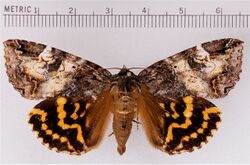Biology:Euparthenos nubilis
| Euparthenos nubilis | |
|---|---|

| |
| Upperside of imago (scale in centimeters) | |
| Scientific classification | |
| Domain: | Eukaryota |
| Kingdom: | Animalia |
| Phylum: | Arthropoda |
| Class: | Insecta |
| Order: | Lepidoptera |
| Superfamily: | Noctuoidea |
| Family: | Erebidae |
| Genus: | Euparthenos Grote, 1876 |
| Species: | E. nubilis
|
| Binomial name | |
| Euparthenos nubilis (Hübner, 1823)
| |
| Synonyms | |
|
See text | |
Euparthenos nubilis (locust underwing) is a species of moth in the family Erebidae and the only member of its genus, Euparthenos. The adults resemble some of the underwing moths of genus Catocala, which are fairly close relatives, in color, pattern, and the habit of resting on tree trunks. But E. nubilis can usually be immediately recognized by the 4 concentric black bands per hindwing, as opposed to one or two (at most 3) in Catocala. Color morphs of E. nubilis with altered pattern are known, however, and these may be hard to recognize without detailed examination.[1]
This moth has light grey forewings with a pattern of darker grey and brown lines and shading. The hindwings are yellow-orange with the aforementioned four black bands each. The wingspan is 56–70 mm (over 2 to almost 3 inches.[2]
The species is found from Maine, Ontario and Quebec, south to northern Florida, west to Nebraska and Arizona. Adults are on wing from April to September. There are two generations per year. The larvae feed on Robinia (locust tree) species, such as Black Locust (Robinia pseudoacacia). The adults like to drink the juice of fermenting fruit, and are attracted to lights.[2]
Systematics and taxonomy
Classification
The species and genus were previously classified in the subfamily Catocalinae of the family Noctuidae and in the tribe Ophiusini of the family Erebidae.[3]
Subspecies
The species has the following described subspecies.[4]
- Euparthenos nubilis apache (Poling, 1901)
- Euparthenos nubilis nubilis (Hübner, 1823)
- Euparthenos nubilis osiris Barnes & Benjamin, 1926
Synonyms
The junior synonyms of this moth are:[4]
- Genus-level:
- Catocalirrhus Andrews, 1877
- Parthenos Hübner, 1823 (non Hübner, 1819: preoccupied)
- Species-level:
- Euparthenos faciata (Beutenmüller, 1907)
- Euparthenos unilineata (Chermock & Chermock, 1940) (morph)
Footnotes
References
- BugGuide (2011): Euparthenos nubilis. Version of 2011-JUN-22. Retrieved 2011-DEC-27.
- Nelson, John M. & Loy, Peter W. (1983): The Underwing Moths (Lepidoptera: Noctuidae) of Oklahoma. Proceedings of the Oklahoma Academy of Science 63: 60-67. PDF fulltext
- Savela, Markku (2001): Markku Savela's Lepidoptera and some other life forms: Euparthenos. Version of 2001-DEC-15. Retrieved 2011-DEC-27.
External links
Wikidata ☰ Q13621024 entry

